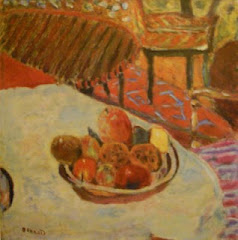From
the glass canyons of downtown L.A., with their sheer walls of windows
reflecting the sky, we took Metro bus 487 fourteen stops through the tangle of
freeways to San Gabriel, at the foot of hazy blue mountains, one capped / captivating
with snow, and when the traffic signals allowed crossed two railway tracks to
Mission San Gabriel Arcángel—one of the last two missions we hadn't seen. In the city of angels, in this time of terror
when we need angels more than ever (to paraphrase Rilke, below), this pilgrimage
to visit the now suburban archangel was important.
Let
not one god pass away. We all need each
of them now,
let
each be valid for us, each image formed in the depths.
Don’t
speak with the slightest disdain of whatever the heart
can know.
(from
The Sonnets to Orpheus, translated by
Stephen Mitchell—who I met one year at BEA there in downtown Los Angeles)
We
made our journey midmorning, after an appropriate Los Angeles breakfast of huevos rancheros, fried eggs with a corn
tortilla, salsa, and pinto beans. Not
quite the chilaquiles I loved in Cancun years ago, but satisfying my sense of
right-being.
It's
not one of the lovelier missions, but it was a poem, inspirational in many
ways.
. palms
and bells and old adobe-covered stairs
. giant
white clam shell basins in the courtyard, holding water with flower petals
. learning
that in carpentry dovetailed means
made without nails
. little
blue tiles around the shrine
. colors
in sacred paintings made from wildflowers, olive oil
. baked
floor tiles
. cistern,
millrace, aqueduct
. soap
and tallow vats
. Our
Lady of Sorrows
.
many charming signs, as below.
"No longer do caravans of traders come
lumbering up to the gates of Mission San Gabriel as in the days of the
Franciscans. No longer are fiestas and
siestas the order of the day.* But
Mission San Gabriel Arcángel continues to enlarge its niche in the hearts of
all, be they casual visitors or members of the Parish, which it has served for
these many years."
*(again, recalling Rilke's "When everything we create is
far in spirit from the festive, / in the midst of our turbulent days let us
think of what festivals were.")
"The five fire circles are original and
once held large iron kettles, such as the one seen here, wherein daily 'Pozole'
or popcorn soup was made over the fires.
Upon the sounding of the 'Angeles' bell at noon and the prayer which it
commanded, the Indians came to be fed."
"One of the original church doors stands
(retired) here. Made of California
redwood. The bronze bosses were brought
from New Spain, Mexico. If the door is
closely observed, it will be noticed that rain-storm and sun have worn the wood
away from the bosses. This door swung on
the south side main church entrance.
Look . . . its mate is over yonder."
And
more than anything, I loved hearing the native guide playing what he called the
River Song on a flute in the mission church, for his small group of
visitors. Explaining that the notes
trickled, as did the sacred river, water vital in that dry land, and the music
perfect for the day. (Tellingly, I've
learned, the erosion of the San Gabriel mountains, into and along the river,
provided gravel, sand, and rock for the construction of the modern city: all those roads, freeways, and parking lots;
coliseum and harbor.)
The
visit was evocative, reminding me of
. visiting
the mission in the desert south of Tucson, Tucumcacori, the winter after my
father died; the mission and nearby spice shop
. visiting
the San Diego mission other years, when I was selling books at the Asian
Studies conference, and drinking genmai cha I'd brought along to ice, in afternoon
sunlight, the luxurious warmth of a southern California early spring
. finding
the paintings of our birthday saints (Eliseo, by Tintoretto; and an Annunciation
by Titian), another February, in the Scuola Grande di San Rocco in Venice
. our
class making a film in a canyon with a little private adobe church one rainy
day in high school, before we went our separate ways
. coming
across the father of the California missions again back in his home church in Palma
de Mallorca one September, orange trees in the cloister
. the
artist in my Bonnard novel, Charles San Gabriel Girard, named
for the mountains his mother came to from Quebec—the beloved San Gabriels of
Eugenie, matriarch of the reclusive Girards.
Gabriel was, as it happens, the angel of the
Annunciation. Clothed in blue or white,
he carries variously a lily, a trumpet, a shining lantern, a branch from
Paradise, a scroll, a scepter. He is
patron of telecommunication workers, radio broadcasters, messengers, postal
workers, clerics, diplomats, stamp collectors, Portugal, ambassadors—so, clearly,
much needed today.
I hope we have made friends. Though as Rilke (surely among the angels
himself) writes at the beginning of the Duino
Elegies:
Who, if I cried out, would hear me among the
angels'
hierarchies? and even if one of them pressed me
suddenly against his heart: I would be consumed
in that overwhelming existence. For beauty is nothing
but the beginning of terror, which we still are
just able to endure,
and we are so awed because it serenely disdains
to annihilate us. Every angel is terrifying.
And, in the next:
But if the archangel now, perilous, from behind
the stars
took even one step down toward us: our own heart, beating
higher and higher, would beat us to death. Who are
you?
images: Christie B. Cochrell, Mission San Gabriel
Archangel Gabriel, Hagia Sophia

























